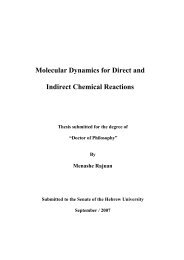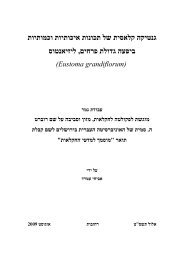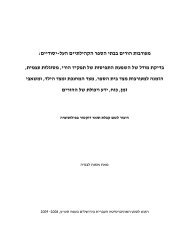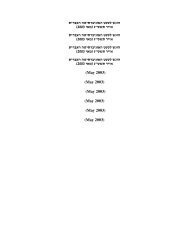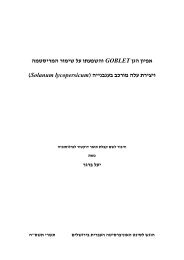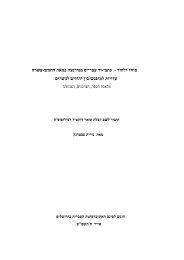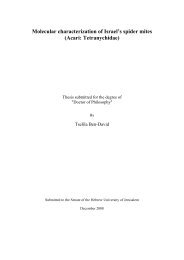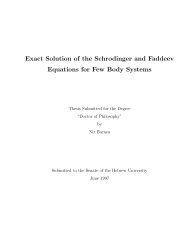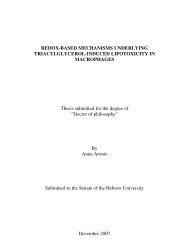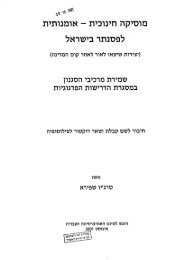Revealing the Mechanism of HSP104 Transcription Initiation in the ...
Revealing the Mechanism of HSP104 Transcription Initiation in the ...
Revealing the Mechanism of HSP104 Transcription Initiation in the ...
Create successful ePaper yourself
Turn your PDF publications into a flip-book with our unique Google optimized e-Paper software.
A)<br />
5’-XhoI<br />
-713<br />
BamHI-3’<br />
ATG<br />
LacZ cod<strong>in</strong>g seq<br />
-641 ATG<br />
-531 ATG<br />
-500 ATG<br />
-334 ATG<br />
-300 ATG<br />
Legend<br />
HSE<br />
HSE cluster<br />
STRE-like<br />
STRE<br />
100 bp<br />
B) C)<br />
600<br />
500<br />
400<br />
SP1<br />
30 0 C<br />
39 0 C<br />
Time <strong>in</strong> 39 0 C 0’ 15’ 30’ 60’ 5hrs<br />
30 0 C<br />
SP1<br />
<strong>HSP104</strong><br />
ACTIN<br />
300<br />
200<br />
100<br />
0<br />
-713 -641 -530 -500 -334 -300<br />
Figure 2. A 334bp fragment <strong>of</strong> <strong>the</strong> <strong>HSP104</strong> promoter is sufficient and essential for both basal<br />
and <strong>in</strong>duced activities <strong>in</strong> wild-type cells (<strong>the</strong> SP1 stra<strong>in</strong>). A) Schematic view <strong>of</strong> various constructs<br />
fused to LacZ cod<strong>in</strong>g sequence, rang<strong>in</strong>g from -713bp to -300bp <strong>of</strong> <strong>the</strong> promoter. B) β-galactosidase<br />
activity <strong>of</strong> <strong>the</strong> various constructs under optimal growth conditions (30 o C) and follow<strong>in</strong>g heat shock<br />
(39 o C for one hour). C) S1 analysis <strong>of</strong> endogenous <strong>HSP104</strong> mRNA at various time po<strong>in</strong>ts dur<strong>in</strong>g heat<br />
shock treatment or under optimal growth conditions.<br />
In order to search for <strong>the</strong> cis-elements required for <strong>the</strong> heat shock <strong>in</strong>duced<br />
transcription <strong>of</strong> <strong>HSP104</strong>, <strong>the</strong> sequences downstream to -300 were fur<strong>the</strong>r analyzed<br />
through 5’deletions. The results are described <strong>in</strong> detail <strong>in</strong> (47). Briefly, we found that<br />
upon deletion <strong>of</strong> <strong>the</strong> HSE cluster (Fig. 3) between -300 and -286, <strong>the</strong> reporter gene<br />
rema<strong>in</strong>ed responsive to heat shock due to <strong>the</strong> presence <strong>of</strong> <strong>the</strong> STREs <strong>of</strong> <strong>the</strong> promoter<br />
(reflected by <strong>the</strong> -284LacZ construct). Removal <strong>of</strong> <strong>the</strong> first distal STRE positioned at<br />
-252 (<strong>in</strong> <strong>the</strong> -248LacZ construct) almost abolished <strong>the</strong> responsiveness <strong>of</strong> <strong>the</strong> reporter<br />
gene. Only residual activity rema<strong>in</strong>ed that was just slightly <strong>in</strong>duced <strong>in</strong> response to<br />
heat shock. This <strong>in</strong>duced activity <strong>of</strong> -248LacZ is due to <strong>the</strong> presence <strong>of</strong> <strong>the</strong> rema<strong>in</strong><strong>in</strong>g<br />
STREs positioned at -220 and -172 because <strong>the</strong>ir deletion completely abolished<br />
reporter activity (Fig. 3B and 3C). As mentioned above, <strong>the</strong> general stress response<br />
via <strong>the</strong> STRE/Msn2/4 system is negatively regulated by <strong>the</strong> Ras/cAMP/PKA pathway<br />
and many stress related genes are upregulated <strong>in</strong> ras2∆ cells (9, 86, 116, 121, 129).<br />
12



